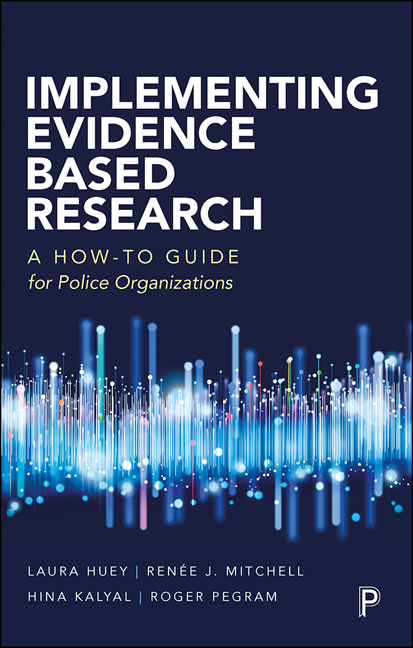Book contents
- Frontmatter
- Contents
- List of tables and figures
- Acknowledgments
- Introduction
- 1 Implementing evidence-based policing
- 2 Situating evidence-based policing
- 3 Understanding research
- 4 The individual approach
- 5 The smaller agency
- 6 The mid-sized agency
- 7 The larger agency
- 8 Generating sustainability
- 9 Resources for evidence-based practices
- Endnotes
- References
- Index
2 - Situating evidence-based policing
Published online by Cambridge University Press: 05 January 2022
- Frontmatter
- Contents
- List of tables and figures
- Acknowledgments
- Introduction
- 1 Implementing evidence-based policing
- 2 Situating evidence-based policing
- 3 Understanding research
- 4 The individual approach
- 5 The smaller agency
- 6 The mid-sized agency
- 7 The larger agency
- 8 Generating sustainability
- 9 Resources for evidence-based practices
- Endnotes
- References
- Index
Summary
Prior to the 1990s, policing across the West was largely conducted through what is known as the ‘standard model’ of policing (Sherman, 2013). This model, also known as the ‘3Rs’, was a ‘one-size-fits-all’ reactive approach that placed heavy emphasis on random patrols, rapid responses to calls for service, and reactive investigations, along with intensive enforcement in the form of police crackdowns and/or saturation policing (Weisburd and Eck, 2004; Sherman, 2013). Despite the apparent popularity of such approaches within policing and political circles, widespread crime rate increases throughout the 1970s and 1980s led some to question the ability of the police to reduce and prevent crime (Bayley, 1994).
Growing doubt about the effectiveness of current policing styles, coupled with a growing body of evidence showing that practices under the standard model had little-to-no impact on crime (Skogan and Frydl, 2004), led to a period of significant innovation within policing. While the standard model was not replaced entirely, new policing processes and philosophies were developed and implemented. These innovations included not only evidence-based policing (EBP), but also problemoriented policing (POP), community-oriented policing (COP), CompStat (Computerized Statistics) and intelligence-led policing (ILP).
One of the questions we are not infrequently asked is, ‘What is the difference between EBP and POP?’ Another is ‘Does EBP replace COP?’ Given the extent to which there is some overlap among these philosophies, and thus some natural confusion about whether they compete or complement one another, we thought it would be helpful to highlight some of the main characteristics and differences, focusing primarily on how each of these philosophies can be made compatible with an EBP approach. Thus, the purpose of this chapter is to situate EBP next to these other policing innovations.
To begin, this chapter will provide an overview of EBP, further expanding on its origins and what Sherman (1998) ultimately intended for it to solve. The focus of the chapter then shifts towards three unique, but complimentary, policing innovations – problem-oriented policing, community policing, and intelligence-led policing – to outline where EBP stands relative to them.
- Type
- Chapter
- Information
- Implementing Evidence Based ResearchA How-to Guide for Police Organizations, pp. 27 - 42Publisher: Bristol University PressPrint publication year: 2021



